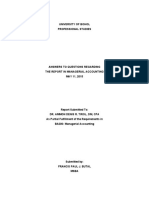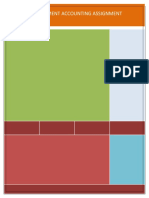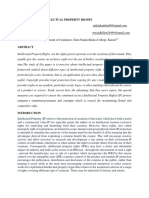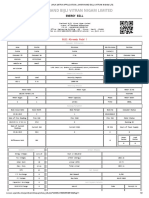Landau Company
Landau Company
Uploaded by
sherwinrsCopyright:
Available Formats
Landau Company
Landau Company
Uploaded by
sherwinrsOriginal Description:
Copyright
Available Formats
Share this document
Did you find this document useful?
Is this content inappropriate?
Copyright:
Available Formats
Landau Company
Landau Company
Uploaded by
sherwinrsCopyright:
Available Formats
Managerial accounting
Case: 19-4 Landau Company
Question 1:
The income statements prepared under absorption costing and variable costing usually produce different net operating income figures. Under absorption costing if inventories increase then some of the fixed manufacturing costs of the current period will not appear on the income statement as part of cost of goods sold. Instead, these costs are deferred to a future period and are carried on the balance sheet as part of the inventory account. Such a deferral of cost is known as fixed manufacturing overhead deferred in inventory, as the accountant said that the July production was well below standard volume because of employee vacations this caused overhead to be under absorbed so as we can see in the income statement a large amount of overhead volume the amount 63,779 is deducted from gross margin and it cause less income however the sales are increased, but in variable costing because we dont include this overhead volume and we have just a fix amount of fix cost for every month this problem is not visible.
Income Statement June and July
Sales revenues Cost of sales at standard Standard gross margin product cost variance labor material overhead volume overhead spending actual gross margin fixed production overhead admin income before taxes 865,428 448,640 380,788 (16,259) 12,416 1,730 3,604 382,729 0 301,250 81,029 865,428 337,517 527,911 (16,259) 12,416 0 3,604 527,672 192,883 301,250 33,539 931,710 521,758 409,952 (11,814) 8,972 (63,779) 2,832 346,163 0 310,351 35,813 931,710 363,367 568,343 (11,814) 8,972 0 2,832 568,333 192,833 310,351 65,109
And as we can see in income statement the income of June under variable costing is 33,539 and under 81,029 under full costing the less income that is showed by variable cost is good to avoid tax and some point, but it is not a good point from owners and banks loaners point of view as the company seems to be not that much profitable, and so variable costing is not a good method to prepare external report.
The absorption costing system makes no distinction between fixed and variable costs; therefore, it is not well suited for CVP computations, which are important for good planning and control. To generate data for cost volume profit (CVP) analysis, it would be necessary to spend considerable time reworking and reclassifying costs on the absorption statement. The variable costing approach to costing units of product works very well with the contribution approach to the income statement, since both concepts are based on the idea of classifying costs by behavior. The variable costing data could be immediately used in CVP computations and so Terry Silver as the marketing manager can understand the variable cost better and July seems to be better month for him.
The argument of the controller to support variable cost that it would eliminate the time consuming efforts of allocating fixed overheads to individual products is true as the variable cost is easier to apply in this situation and as variable costing segregate the cost of materials, direct labor and etc from fixed overhead cost managements cost control efforts would be enhanced. And also using variable costing to find the profitability of some individual product will help us to determine the product which is more desirable one to sell, because we dont apply all of the overhead volume on all products, but there will be some problem with paying the fix costs if we start to mark up the products in basis on their variable costs. As we can see under variable costing product 243 is more desirable one to sell, but it is not a proper method for marking up the cost of products.
Full Costing
Product 129 243 standard Production cost 2.54 3.05 Selling price 4.34 5.89 unit margin 1.8 2.84 margin percent 41.5 82.5
Variable Costing
Product 129 243 standard Production cost 1.38 2.37 Selling price 4.34 5.89 unit margin 2.96 3.52 margin percent 68.2 59.8
Question 2: I think choosing variable costing for monthly income statement is not a good decision as this costing method has some disadvantage the same as its advantages, as we said the variable costing has some advantages such as The data that are required for cost volume profit (CVP) analysis can be taken directly from a variable costing format income statement. These data are not available on a conventional income statement based on absorption costing. Under variable costing, the profit for a period is not affected by changes in inventories. Other things remaining the same (i.e. selling prices, costs, sales mix, etc.), profits move in the same direction as sales when variable costing is in use. Managers often assume that unit product costs are variable costs. This is a problem under absorption costing, since unit product costs are a combination of both fixed and variable costs. Under variable costing, unit product costs do not contain fixed costs. But despite these advantages, absorption costing must be used almost exclusively for external reporting purposes and it is predominant choice for internal reports as well. Absorption costing is also attractive to many accountants because they believe it better matches costs with revenues. Advocates of absorption costing argue that all manufacturing costs must be assigned to products in order to properly match the costs of producing units of product with the revenues from the units when they are sold. The fixed costs of depreciation, taxes, insurance, supervisory, salaries, and so on, are just as essential to manufacturing products as are the variable costs. Advocates of variable costing argue that fixed manufacturing costs are not really the costs of any particular unit of product. These costs are incurred to have the capacity to make products during a particular period and will be incurred even if nothing is made during the period. Moreover, whether a unit is made or not, the fixed manufacturing cost will be exactly the same. Therefore, variable costing advocates argue that fixed manufacturing costs are not part of the costs of producing a particular unit of product and thus the matching principle dictates that fixed manufacturing costs should be charged to the current period. At any rate, absorption costing is the generally accepted method for preparing mandatory external financial reports and income tax returns, but as absorption costing it is not so useful for management to use to make decision, planning and control they can prepare a variable costing statement for these reasons.
You might also like
- Cost Accounting and Control OutputDocument21 pagesCost Accounting and Control OutputApril Joy Obedoza100% (5)
- ACCA F5 - Part A - Specialist Cost and Management Accounting TechniquesDocument5 pagesACCA F5 - Part A - Specialist Cost and Management Accounting TechniquesMuneera Al Hassan100% (2)
- Differences Between Organization ChangeDocument3 pagesDifferences Between Organization ChangehksNo ratings yet
- Cost Accounting Questions and Their AnswersDocument5 pagesCost Accounting Questions and Their Answerszulqarnainhaider450_No ratings yet
- Income Effects of Alternative Cost Accumulation SystemsDocument4 pagesIncome Effects of Alternative Cost Accumulation Systemssserwadda100% (1)
- Vendmart - TheDocument6 pagesVendmart - TheSagarrajaNo ratings yet
- UGB253 Management Accounting Business FinalDocument15 pagesUGB253 Management Accounting Business FinalMohamed AzmalNo ratings yet
- Marginal and Absorption CostingDocument9 pagesMarginal and Absorption Costingpeyushkumar15No ratings yet
- MAS Variable and Absorption CostingDocument11 pagesMAS Variable and Absorption CostingGwyneth TorrefloresNo ratings yet
- Case StudyDocument19 pagesCase StudyAnutaj NagpalNo ratings yet
- UNIT 3 Absorption Variable CostingDocument19 pagesUNIT 3 Absorption Variable Costingannabelle albaoNo ratings yet
- Assignment - Management AccountingDocument16 pagesAssignment - Management AccountingPriyaNo ratings yet
- Cost Accounting AssignmentDocument12 pagesCost Accounting Assignmentridhim khandelwalNo ratings yet
- Break Even Analysis: Costing Systems and Techniques For Engineering CompaniesDocument6 pagesBreak Even Analysis: Costing Systems and Techniques For Engineering Companiesasimrafiq12No ratings yet
- Case Descriptive Solve 2Document8 pagesCase Descriptive Solve 2rocken samiunNo ratings yet
- AIOU8408 Assignment 1 0000603169Document18 pagesAIOU8408 Assignment 1 0000603169Farhan ShakilNo ratings yet
- Cost Accounting ProjectDocument2 pagesCost Accounting Projectaloksemail2011No ratings yet
- P2 - Performance ManagementDocument11 pagesP2 - Performance Managementmrshami7754No ratings yet
- Marginal and Absorption CostingDocument5 pagesMarginal and Absorption CostingHrutik DeshmukhNo ratings yet
- State Four Underlying Assumptions For Cost-Volume-Profit AnalysisDocument7 pagesState Four Underlying Assumptions For Cost-Volume-Profit Analysismehazabin anamikaNo ratings yet
- Re Answers To The Questions of My ReportDocument9 pagesRe Answers To The Questions of My ReportFrancis Paul ButalNo ratings yet
- Marginal Costing and Absorption CostingDocument28 pagesMarginal Costing and Absorption Costingmanas_samantaray28No ratings yet
- Whiz Calculator Case StudyDocument4 pagesWhiz Calculator Case StudyKinjal MehtaNo ratings yet
- Group 17 - MADM CAT III - Case Study 2 SolutionDocument7 pagesGroup 17 - MADM CAT III - Case Study 2 SolutionGauri SinghNo ratings yet
- Finals Controllership 1Document7 pagesFinals Controllership 1echonntz0515No ratings yet
- Cost Accounting 1Document5 pagesCost Accounting 1Jappy QuilasNo ratings yet
- Advantages and Disadvantages of Marginal CostingDocument4 pagesAdvantages and Disadvantages of Marginal CostingnileshmsawantNo ratings yet
- Variable and Absorption CostingDocument3 pagesVariable and Absorption CostingAreeb Baqai100% (1)
- Management Accounting AssignmentDocument21 pagesManagement Accounting AssignmentAadi KaushikNo ratings yet
- Management Accounting AssignmentDocument21 pagesManagement Accounting AssignmentAadi KaushikNo ratings yet
- Management Accounting AssignmentDocument21 pagesManagement Accounting AssignmentAadi KaushikNo ratings yet
- Cost Volume Profit AnalysisDocument22 pagesCost Volume Profit AnalysisKirai Kiraikenks100% (1)
- Costing Marginal Final Sem 2Document37 pagesCosting Marginal Final Sem 2Abdul Qadir EzzyNo ratings yet
- Mid Term Assignment On: The Superior University LahoreDocument9 pagesMid Term Assignment On: The Superior University LahoreFaizan ChNo ratings yet
- Chapter 13 Variable CostingDocument3 pagesChapter 13 Variable CostingJJ JaumNo ratings yet
- Break Even AnalysisDocument14 pagesBreak Even AnalysisChitrank KaushikNo ratings yet
- Allocation Forcosts of JointProducts ByproductsDocument4 pagesAllocation Forcosts of JointProducts ByproductsMd. Ridoy HossainNo ratings yet
- Unit Three Flexible Budget and StandardsDocument17 pagesUnit Three Flexible Budget and StandardsShimelis TesemaNo ratings yet
- Chapter 3 Accounting and Finance For ManagersDocument17 pagesChapter 3 Accounting and Finance For ManagersSiraj MohammedNo ratings yet
- BEP&CVPDocument10 pagesBEP&CVPNishanth PrabhakarNo ratings yet
- CH 8Document19 pagesCH 8Isra' I. SweilehNo ratings yet
- Cost & Management Accounting (ACT 301) : Department: BBA Group: 1Document7 pagesCost & Management Accounting (ACT 301) : Department: BBA Group: 1Mony MstNo ratings yet
- Summary and Reflection: Chapter 6: Cost-Volume-ProfitDocument5 pagesSummary and Reflection: Chapter 6: Cost-Volume-ProfitJohn Kenneth BoholNo ratings yet
- FIN 5107-CVP AND BREAKEVEN ANALYSISDocument24 pagesFIN 5107-CVP AND BREAKEVEN ANALYSISwilbertmauya1No ratings yet
- Marginal Costing - DefinitionDocument15 pagesMarginal Costing - DefinitionShivani JainNo ratings yet
- Coursematerial mmzg511 MOML15Document6 pagesCoursematerial mmzg511 MOML15srikanth_bhairiNo ratings yet
- Q.1 Selected Financial Information About Vijay Merchant CompanyDocument11 pagesQ.1 Selected Financial Information About Vijay Merchant CompanyUttam SinghNo ratings yet
- ReportDocument39 pagesReportNalynCasNo ratings yet
- Cost Volume Profit AnalysisDocument35 pagesCost Volume Profit AnalysisChairul AnamNo ratings yet
- Flexible Budget N Overhead VarianceDocument16 pagesFlexible Budget N Overhead Variancenotes.mcpuNo ratings yet
- Reducing Overhead Cost PDFDocument6 pagesReducing Overhead Cost PDFAbdul Rahman SabraNo ratings yet
- Balakrishnan MGRL Solutions Ch09Document53 pagesBalakrishnan MGRL Solutions Ch09Rachna Menon100% (1)
- Break Even AnalysisDocument16 pagesBreak Even Analysisapi-3723983100% (9)
- MB0041 AccountsDocument10 pagesMB0041 AccountsvermaksatishNo ratings yet
- Types of CostingDocument14 pagesTypes of CostingAparna Patel BarbieNo ratings yet
- Costing and Profit PlanningDocument27 pagesCosting and Profit PlanningSIDDHANT CHUGHNo ratings yet
- How To Start A Consulting BusinessDocument28 pagesHow To Start A Consulting BusinessSatyabrat DasNo ratings yet
- Unit 6: Selling: Hamyphan R&W1Document8 pagesUnit 6: Selling: Hamyphan R&W1Thu Anh NguyễnNo ratings yet
- Branding From The Inside OutDocument5 pagesBranding From The Inside Outtausif_7827No ratings yet
- Goodyear Brand HistoryDocument4 pagesGoodyear Brand HistoryBenard ChimhondoNo ratings yet
- Nykaa: Company DescriptionDocument8 pagesNykaa: Company Descriptionsrv 99No ratings yet
- Final ReportDocument16 pagesFinal ReportShahida HaqueNo ratings yet
- FLR 02Document7 pagesFLR 02BilalNo ratings yet
- 2023+Q2+ +Digital+PlannerDocument41 pages2023+Q2+ +Digital+PlannerKatherine Shmygun100% (2)
- Marketing Olpers and MilkpakDocument33 pagesMarketing Olpers and Milkpakbutterfily100% (1)
- Content Strategy Case Study: 36,282 Readers + 1,000 Email SubscribersDocument48 pagesContent Strategy Case Study: 36,282 Readers + 1,000 Email SubscribersVinicius SiqueiraNo ratings yet
- Bank Service QualityDocument11 pagesBank Service Qualityirenek100% (5)
- P&G and UnileverDocument22 pagesP&G and UnileverJustin Htoo0% (1)
- Marketing Management Concepts - Assignment-08-06-2021Document13 pagesMarketing Management Concepts - Assignment-08-06-2021Shashwat GuptaNo ratings yet
- HRM Case StudyDocument18 pagesHRM Case StudyAbhijeet DasNo ratings yet
- Phillip Kevin Lane: Kotler - KellerDocument38 pagesPhillip Kevin Lane: Kotler - KellergudzzNo ratings yet
- Intellectual Property RightsDocument7 pagesIntellectual Property RightsNIKHILNo ratings yet
- Using Advertising and Promotion To Build BrandsDocument33 pagesUsing Advertising and Promotion To Build BrandsMuhammad Awais SabirNo ratings yet
- Saxonville Sausage CompanyDocument12 pagesSaxonville Sausage CompanyAustin Grace WeeNo ratings yet
- Free Accounting Firm Business PlanDocument1 pageFree Accounting Firm Business PlansolomonNo ratings yet
- Urja Mitra Application - Jharkhand Bijli Vitran Nigam LTD - DumkaDocument2 pagesUrja Mitra Application - Jharkhand Bijli Vitran Nigam LTD - DumkaSaket KumarNo ratings yet
- Chapter 4 Brand ManagementDocument95 pagesChapter 4 Brand ManagementNatnael AsnakeNo ratings yet
- TataDocument3 pagesTataayona12340000No ratings yet
- Cost Accounting Spoilage and Rework and ScrapDocument33 pagesCost Accounting Spoilage and Rework and Scrapsmnth rsrrctnNo ratings yet
- BusinessDocument11 pagesBusinessRehan AhmadNo ratings yet
- Elasticity of DemandDocument20 pagesElasticity of Demandkapil_dube_1100% (3)
- MediaReachOMD - Rotimi Ogunwede & Joshua FakayodeDocument9 pagesMediaReachOMD - Rotimi Ogunwede & Joshua FakayodeCHININo ratings yet
- Chief Creative Officer or Executive Creative Director or CreativDocument3 pagesChief Creative Officer or Executive Creative Director or Creativapi-77389722No ratings yet
- Comminication Objectives & EffectsDocument11 pagesComminication Objectives & EffectsAvinash SupkarNo ratings yet
- The Nature of Strategic ManagementDocument46 pagesThe Nature of Strategic ManagementRehan FarhatNo ratings yet

























































































